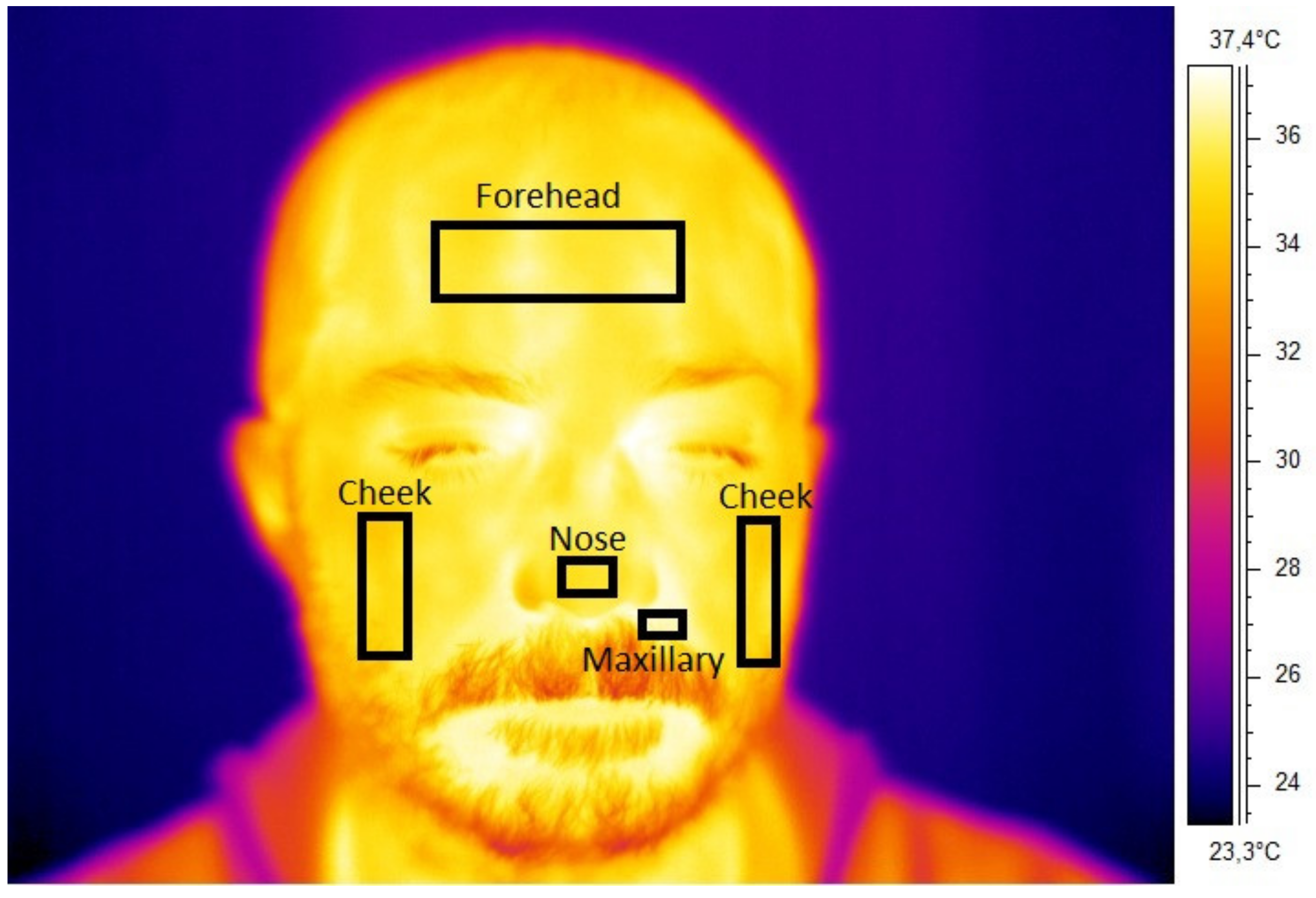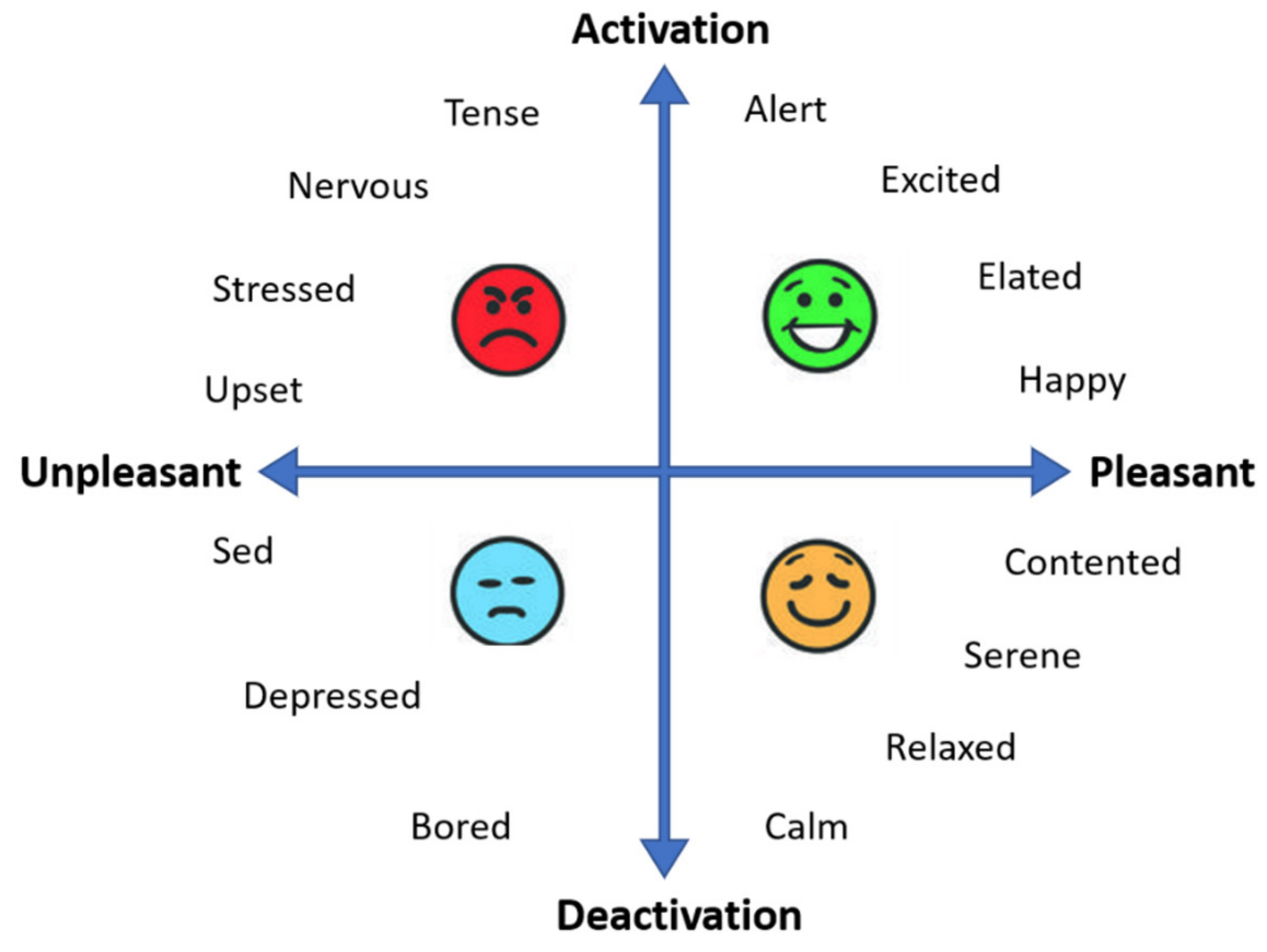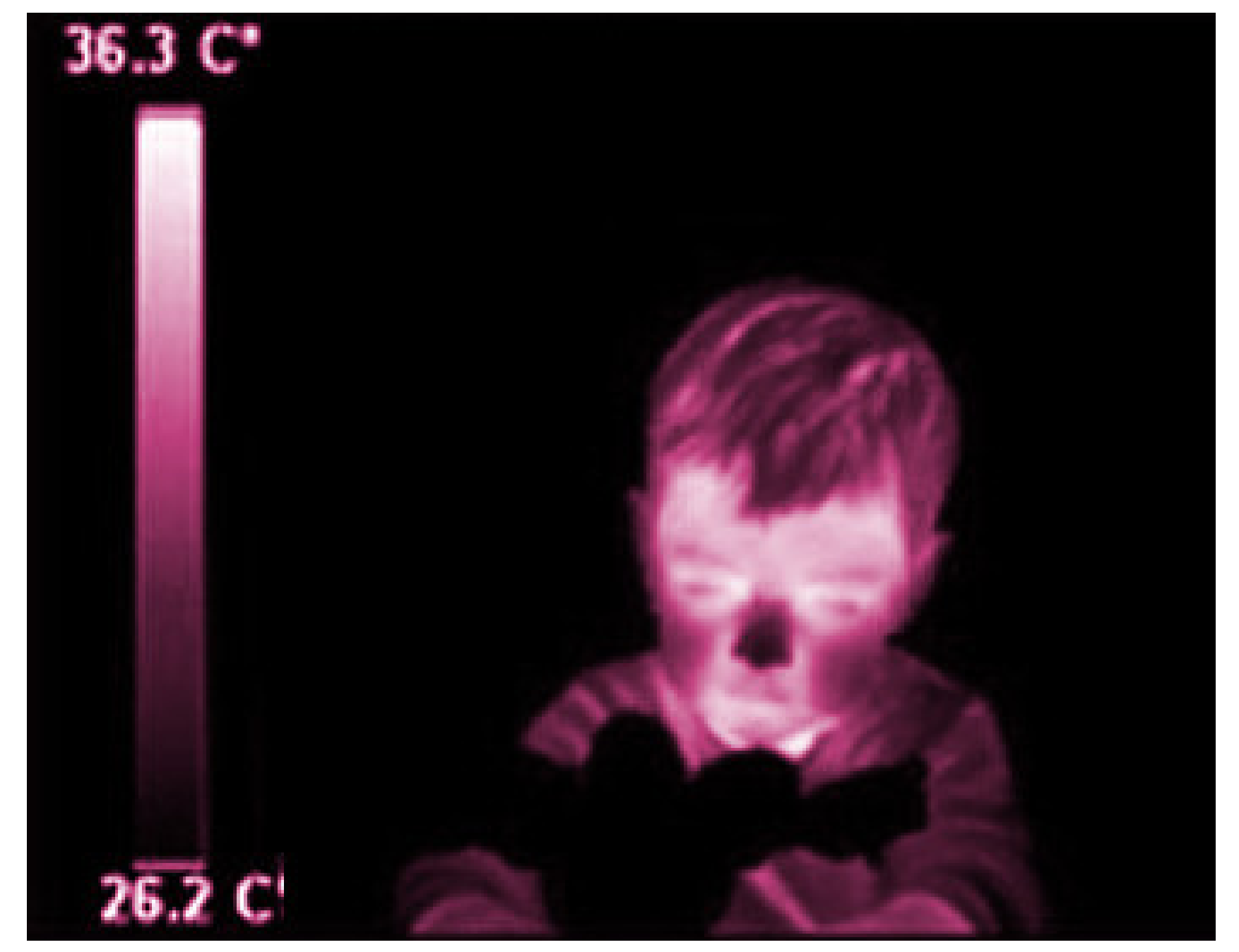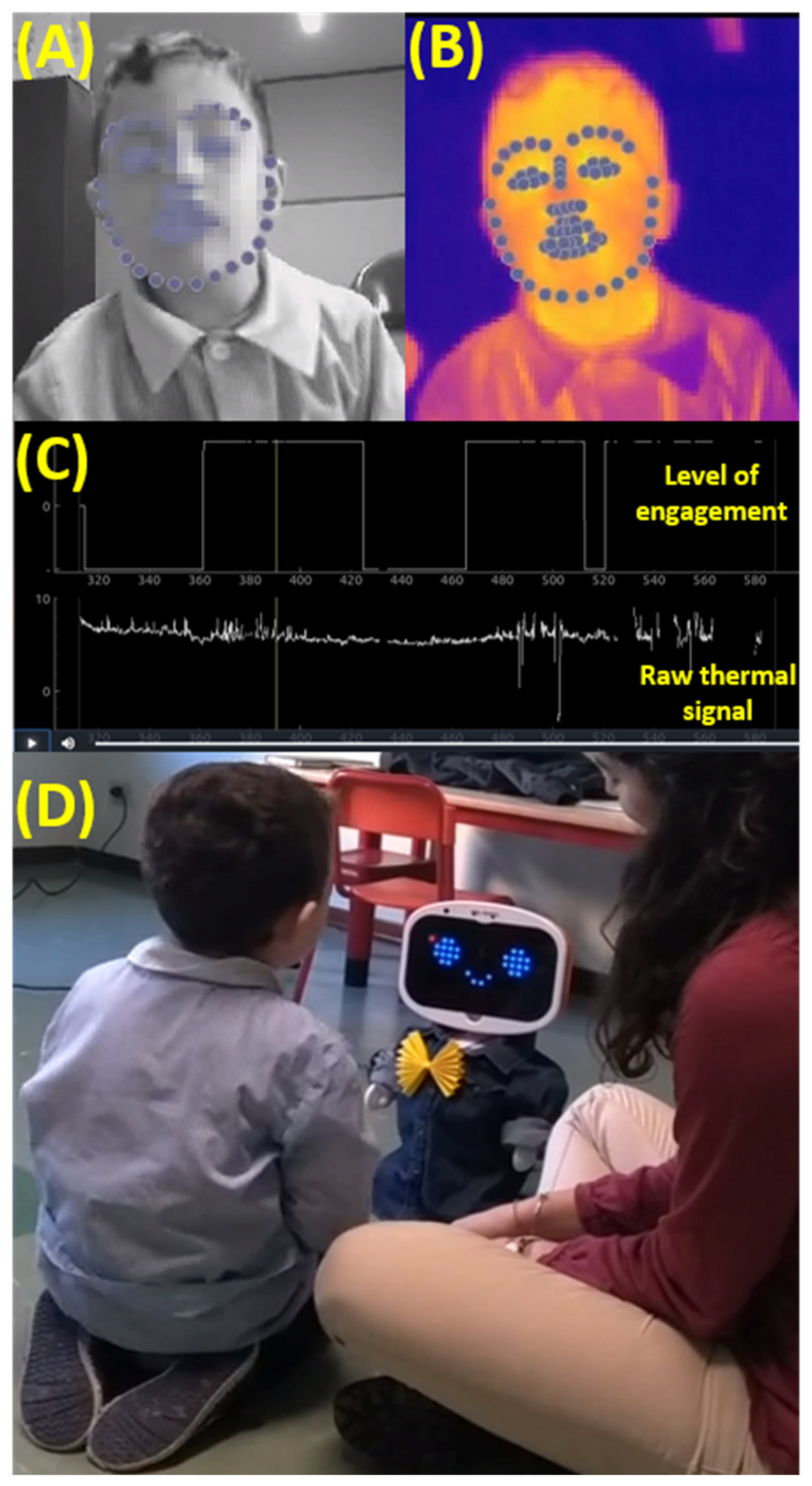Thermal Infrared Imaging-Based Affective Computing and Its Application to Facilitate Human Robot Interaction: A Review
Abstract
1. Introduction
2. Study Organization and Search Processing Method
3. The Importance of Facilitating Human–Robot Interaction
4. Affective States Recognition through Thermal IR Imaging
5. Limits of Current Thermal IR Imaging for HRI Applications
6. Mobile Thermal IR Imaging
7. Thermal IR Imaging-Based Affective Computing Outside Laboratory Settings
8. Thermal IR Imaging-Based Affective Computing in HRI
9. Thermal IR Imaging-Based Affective Computing in Intelligent Systems Such as Driver-Assistance Systems or Autonomous Vehicles
10. Discussion
11. Conclusions
Author Contributions
Funding
Conflicts of Interest
References
- Sung, J.-Y.; Guo, L.; Grinter, R.E.; Christensen, H.I. “My Roomba is Rambo”: Intimate home appliances. In Proceedings of the International Conference on Ubiquitous Computing, Innsbruck, Austria, 16–19 September 2007; Springer: Berlin/Heidelberg, Germany, 2007; pp. 145–162. [Google Scholar]
- Dautenhahn, K. Methodology & themes of human-robot interaction: A growing research field. Int. J. Adv. Robot. Syst. 2007, 4, 15. [Google Scholar]
- Salter, T.; Werry, I.; Michaud, F. Going into the wild in child–robot interaction studies: Issues in social robotic development. Intell. Serv. Robot. 2008, 1, 93–108. [Google Scholar] [CrossRef]
- Horvitz, E.; Paek, T. Harnessing models of users’ goals to mediate clarification dialog in spoken language systems. In Proceedings of the International Conference on User Modeling, Sonthofen, Germany, 13–17 July 2001; Springer: Berlin/Heidelberg, Germany, 2001; pp. 3–13. [Google Scholar]
- Kahn, P.H., Jr.; Ishiguro, H.; Friedman, B.; Kanda, T.; Freier, N.G.; Severson, R.L.; Miller, J. What is a Human? Toward psychological benchmarks in the field of human–robot interaction. Interact. Stud. 2007, 8, 363–390. [Google Scholar]
- Duffy, B.R. Anthropomorphism and the social robot. Robot. Auton. Syst. 2003, 42, 177–190. [Google Scholar] [CrossRef]
- Turkle, S. In good company? On the threshold of robotic companions. In Close Engagements with Artificial Companions; John Benjamins: Amsterdam, The Netherlands, 2010; pp. 3–10. [Google Scholar]
- Thomasen, K. Examining the constitutionality of robot-enhanced interrogation. In Robot Law; Edward Elgar Publishing: Cheltenham, UK, 2016. [Google Scholar]
- Darling, K. Extending legal protection to social robots: The effects of anthropomorphism, empathy, and violent behavior towards robotic objects. In Robot Law; Edward Elgar Publishing: Cheltenham, UK, 2016. [Google Scholar]
- Darling, K. ’Who’s Johnny?’Anthropomorphic Framing in Human-Robot Interaction, Integration, and Policy. Anthr. Fram. Hum. Robot Interact. Integr. Policy March 23 2015 ROBOT ETHICS 2015, 2. [Google Scholar] [CrossRef]
- Press, T.M. Affective Computing. Available online: https://mitpress.mit.edu/books/affective-computing (accessed on 27 December 2019).
- Russell, J.A.; Bachorowski, J.-A.; Fernández-Dols, J.-M. Facial and vocal expressions of emotion. Annu. Rev. Psychol. 2003, 54, 329–349. [Google Scholar] [CrossRef] [PubMed]
- Fernandes, A.; Helawar, R.; Lokesh, R.; Tari, T.; Shahapurkar, A.V. Determination of stress using blood pressure and galvanic skin response. In Proceedings of the 2014 International Conference on Communication and Network Technologies, 2014, Sivakasi, India, 18–19 December 2014; pp. 165–168. [Google Scholar]
- Bradley, M.M.; Lang, P.J. Measuring emotion: Behavior, feeling, and physiology. Cogn. Neurosci. Emot. 2000, 25, 49–59. [Google Scholar]
- Schachter, S.; Singer, J. Cognitive, social, and physiological determinants of emotional state. Psychol. Rev. 1962, 69, 379. [Google Scholar] [CrossRef]
- Knapp, R.B.; Kim, J.; André, E. Physiological signals and their use in augmenting emotion recognition for human–machine interaction. In Emotion-Oriented Systems; Springer: Berlin/Heidelberg, Germany, 2011; pp. 133–159. [Google Scholar]
- Reynolds, C.; Picard, R. Affective sensors, privacy, and ethical contracts. In Proceedings of the CHI’04 Extended Abstracts on Human Factors in Computing Systems, 2004, Vienna, Austria, 24–29 April 2004; pp. 1103–1106. [Google Scholar]
- Sebe, N.; Sun, Y.; Bakker, E.; Lew, M.S.; Cohen, I.; Huang, T.S. Towards authentic emotion recognition. In Proceedings of the 2004 IEEE International Conference on Systems, Man and Cybernetics (IEEE Cat. No. 04CH37583), Hague, The Netherlands, 10–13 October 2004; Volume 1, pp. 623–628. [Google Scholar]
- Schmidt, K.L.; Cohn, J.F. Human facial expressions as adaptations: Evolutionary questions in facial expression research. Am. J. Phys. Anthropol. Off. Publ. Am. Assoc. Phys. Anthropol. 2001, 116, 3–24. [Google Scholar] [CrossRef]
- Crivelli, C.; Fridlund, A.J. Facial displays are tools for social influence. Trends Cogn. Sci. 2018, 22, 388–399. [Google Scholar] [CrossRef]
- Wioleta, S. Using physiological signals for emotion recognition. In Proceedings of the 2013 6th International Conference on Human System Interactions (HSI), 2013, Sopot, Poland, 6–8 June 2013; pp. 556–561. [Google Scholar]
- Jerritta, S.; Murugappan, M.; Nagarajan, R.; Wan, K. Physiological signals based human emotion recognition: A review. In Proceedings of the 2011 IEEE 7th International Colloquium on Signal Processing and its Applications, 2011, Penang, Malaysia, 4–6 March 2011; pp. 410–415. [Google Scholar]
- Basu, A.; Routray, A.; Shit, S.; Deb, A.K. Human emotion recognition from facial thermal image based on fused statistical feature and multi-class SVM. In Proceedings of the 2015 Annual IEEE India Conference (INDICON), 2015, New Delhi, India, 17–20 December 2015; pp. 1–5. [Google Scholar]
- Puri, C.; Olson, L.; Pavlidis, I.; Levine, J.; Starren, J. StressCam: Non-contact measurement of users’ emotional states through thermal imaging. In Proceedings of the CHI’05 extended abstracts on Human factors in computing systems, 2005, Portland, OR, USA, 2–7 April 2005; pp. 1725–1728. [Google Scholar]
- Wang, S.; He, M.; Gao, Z.; He, S.; Ji, Q. Emotion recognition from thermal infrared images using deep Boltzmann machine. Front. Comput. Sci. 2014, 8, 609–618. [Google Scholar] [CrossRef]
- Cross, C.B.; Skipper, J.A.; Petkie, D.T. Thermal imaging to detect physiological indicators of stress in humans. In Proceedings of the Thermosense: Thermal Infrared Applications XXXV, Baltimore, MD, USA, 30 April–2 May 2013; International Society for Optics and Photonics: Bellingham, WA, USA, 2013; Volume 8705, p. 87050. [Google Scholar]
- Cardone, D.; Pinti, P.; Merla, A. Thermal infrared imaging-based computational psychophysiology for psychometrics. Comput. Math. Methods Med. 2015, 2015. [Google Scholar] [CrossRef] [PubMed]
- Engert, V.; Merla, A.; Grant, J.A.; Cardone, D.; Tusche, A.; Singer, T. Exploring the Use of Thermal Infrared Imaging in Human Stress Research. PLoS ONE 2014, 9. [Google Scholar] [CrossRef] [PubMed]
- Ebisch, S.J.; Aureli, T.; Bafunno, D.; Cardone, D.; Romani, G.L.; Merla, A. Mother and child in synchrony: Thermal facial imprints of autonomic contagion. Biol. Psychol. 2012, 89, 123–129. [Google Scholar] [CrossRef]
- Paolini, D.; Alparone, F.R.; Cardone, D.; van Beest, I.; Merla, A. “The face of ostracism”: The impact of the social categorization on the thermal facial responses of the target and the observer. Acta Psychol. (Amst.) 2016, 163, 65–73. [Google Scholar] [CrossRef]
- Di Giacinto, A.; Brunetti, M.; Sepede, G.; Ferretti, A.; Merla, A. Thermal signature of fear conditioning in mild post traumatic stress disorder. Neuroscience 2014, 266, 216–223. [Google Scholar] [CrossRef]
- Panasiti, M.S.; Cardone, D.; Pavone, E.F.; Mancini, A.; Merla, A.; Aglioti, S.M. Thermal signatures of voluntary deception in ecological conditions. Sci. Rep. 2016, 6, 1–10. [Google Scholar] [CrossRef]
- Aureli, T.; Grazia, A.; Cardone, D.; Merla, A. Behavioral and facial thermal variations in 3-to 4-month-old infants during the Still-Face Paradigm. Front. Psychol. 2015, 6. [Google Scholar] [CrossRef]
- Perpetuini, D.; Cardone, D.; Filippini, C.; Chiarelli, A.M.; Merla, A. Modelling Impulse Response Function of Functional Infrared Imaging for General Linear Model Analysis of Autonomic Activity. Sensors 2019, 19, 849. [Google Scholar] [CrossRef]
- Perpetuini, D.; Cardone, D.; Chiarelli, A.M.; Filippini, C.; Croce, P.; Zappasodi, F.; Rotunno, L.; Anzoletti, N.; Zito, M.; Merla, A. Autonomic impairment in Alzheimer’s disease is revealed by complexity analysis of functional thermal imaging signals during cognitive tasks. Physiol. Meas. 2019, 40, 034002. [Google Scholar] [CrossRef]
- Kitchenham, B. Procedures for Performing Systematic Reviews; Keele University: Keele, UK, 2004; Volume 33, pp. 1–26. [Google Scholar]
- Belpaeme, T.; Kennedy, J.; Ramachandran, A.; Scassellati, B.; Tanaka, F. Social robots for education: A review. Sci. Robot. 2018, 3. [Google Scholar] [CrossRef]
- Girotto, V.; Lozano, C.; Muldner, K.; Burleson, W.; Walker, E. Lessons Learned from In-School Use of rTAG: A Robo-Tangible Learning Environment. In Proceedings of the 2016 CHI Conference on Human Factors in Computing Systems, Association for Computing Machinery, New York USA. San Jose, CA, USA, 7–12 May 2016; pp. 919–930. [Google Scholar]
- Movellan, J.; Eckhardt, M.; Virnes, M.; Rodriguez, A. Sociable robot improves toddler vocabulary skills. In Proceedings of the 4th ACM/IEEE International Conference on Human Robot Interaction, La Jolla, CA, USA, 9–13 March 2009; pp. 307–308. [Google Scholar]
- Tanaka, F.; Isshiki, K.; Takahashi, F.; Uekusa, M.; Sei, R.; Hayashi, K. Pepper learns together with children: Development of an educational application. In Proceedings of the 2015 IEEE-RAS 15th International Conference on Humanoid Robots (Humanoids), Seoul, Korea, 3–5 November 2015; pp. 270–275. [Google Scholar]
- Banks, M.R.; Willoughby, L.M.; Banks, W.A. Animal-assisted therapy and loneliness in nursing homes: Use of robotic versus living dogs. J. Am. Med. Dir. Assoc. 2008, 9, 173–177. [Google Scholar] [CrossRef] [PubMed]
- Hodges, H.; Fealko, C.; Soares, N. Autism spectrum disorder: Definition, epidemiology, causes, and clinical evaluation. Transl. Pediatr. 2020, 9, S55. [Google Scholar] [CrossRef] [PubMed]
- Olaronke, I.; Oluwaseun, O.; Rhoda, I. State of The Art: A Study of Human-Robot Interaction in Healthcare. Int. J. Inf. Eng. Electron. Bus. 2017, 9, 43–55. [Google Scholar] [CrossRef]
- Cabibihan, J.-J.; Javed, H.; Ang, M.; Aljunied, S.M. Why robots? A survey on the roles and benefits of social robots in the therapy of children with autism. Int. J. Soc. Robot. 2013, 5, 593–618. [Google Scholar] [CrossRef]
- Sartorato, F.; Przybylowski, L.; Sarko, D.K. Improving therapeutic outcomes in autism spectrum disorders: Enhancing social communication and sensory processing through the use of interactive robots. J. Psychiatr. Res. 2017, 90, 1–11. [Google Scholar] [CrossRef]
- Wilson, K.P.; Landa, R.J. Barriers to Educator Implementation of a Classroom-Based Intervention for Preschoolers with Autism Spectrum Disorder. Front. Educ. 2019, 4. [Google Scholar] [CrossRef]
- Tussyadiah, I.P.; Park, S. Consumer Evaluation of Hotel Service Robots. In Proceedings of the Information and Communication Technologies in Tourism, Jönköping, Sweden, 24–26 January 2018; Stangl, B., Pesonen, J., Eds.; Springer International Publishing: Cham, Switzerland, 2018; pp. 308–320. [Google Scholar]
- Niculescu, A.I.; Jiang, R.; Kim, S.; Yeo, K.H.; D’Haro, L.F.; Niswar, A.; Banchs, R.E. SARA: Singapore’s Automated Responsive Assistant, A Multimodal Dialogue System for Touristic Information. In Proceedings of the Mobile Web Information Systems, Barcelona, Spain, 27–29 August 2014; Awan, I., Younas, M., Franch, X., Quer, C., Eds.; Springer International Publishing: Cham, Switzerland, 2014; pp. 153–164. [Google Scholar]
- D’Haro, L.F.; Kim, S.; Yeo, K.H.; Jiang, R.; Niculescu, A.I.; Banchs, R.E.; Li, H. CLARA: A Multifunctional Virtual Agent for Conference Support and Touristic Information. In Natural Language Dialog Systems and Intelligent Assistants; Lee, G.G., Kim, H.K., Jeong, M., Kim, J.-H., Eds.; Springer International Publishing: Cham, Switzerland, 2015; pp. 233–239. ISBN 978-3-319-19291-8. [Google Scholar]
- de Kervenoael, R.; Hasan, R.; Schwob, A.; Goh, E. Leveraging human-robot interaction in hospitality services: Incorporating the role of perceived value, empathy, and information sharing into visitors’ intentions to use social robots. Tour. Manag. 2020, 78, 104042. [Google Scholar] [CrossRef]
- Cross, E.S.; Hortensius, R.; Wykowska, A. From social brains to social robots: Applying neurocognitive insights to human–robot interaction. Philos. Trans. R. Soc. B Biol. Sci. 2019, 374, 20180024. [Google Scholar] [CrossRef]
- Abdelrahman, Y.; Velloso, E.; Dingler, T.; Schmidt, A.; Vetere, F. Cognitive heat: Exploring the usage of thermal imaging to unobtrusively estimate cognitive load. Proc. ACM Interact. Mob. Wearable Ubiquitous Technol. 2017, 1, 1–20. [Google Scholar] [CrossRef]
- Salazar-López, E.; Domínguez, E.; Juárez Ramos, V.; de la Fuente, J.; Meins, A.; Iborra, O.; Gálvez, G.; Rodríguez-Artacho, M.A.; Gómez-Milán, E. The mental and subjective skin: Emotion, empathy, feelings and thermography. Conscious. Cogn. 2015, 34, 149–162. [Google Scholar] [CrossRef] [PubMed]
- Pavlidis, I.; Tsiamyrtzis, P.; Shastri, D.; Wesley, A.; Zhou, Y.; Lindner, P.; Buddharaju, P.; Joseph, R.; Mandapati, A.; Dunkin, B. Fast by nature-how stress patterns define human experience and performance in dexterous tasks. Sci. Rep. 2012, 2, 305. [Google Scholar] [CrossRef] [PubMed]
- Ioannou, S.; Gallese, V.; Merla, A. Thermal infrared imaging in psychophysiology: Potentialities and limits. Psychophysiology 2014, 51, 951–963. [Google Scholar] [CrossRef] [PubMed]
- Cruz-Albarran, I.A.; Benitez-Rangel, J.P.; Osornio-Rios, R.A.; Morales-Hernandez, L.A. Human emotions detection based on a smart-thermal system of thermographic images. Infrared Phys. Technol. 2017, 81, 250–261. [Google Scholar] [CrossRef]
- Goulart, C.; Valadão, C.; Delisle-Rodriguez, D.; Caldeira, E.; Bastos, T. Emotion analysis in children through facial emissivity of infrared thermal imaging. PLoS ONE 2019, 14. [Google Scholar] [CrossRef] [PubMed]
- Mehrabian, A. Pleasure-arousal-dominance: A general framework for describing and measuring individual differences in temperament. Curr. Psychol. 1996, 14, 261–292. [Google Scholar] [CrossRef]
- Posner, J.; Russell, J.A.; Peterson, B.S. The circumplex model of affect: An integrative approach to affective neuroscience, cognitive development, and psychopathology. Dev. Psychopathol. 2005, 17, 715–734. [Google Scholar] [CrossRef]
- Zhong, K.; Qiao, T.; Zhang, L. A Study of Emotional Communication of Emoticon Based on Russell’s Circumplex Model of Affect. In Proceedings of the Design, User Experience, and Usability Design Philosophy and Theory, Orlando, FL, US, 26–31 July 2019; Marcus, A., Wang, W., Eds.; Springer International Publishing: Cham, Switzerland, 2019; pp. 577–596. [Google Scholar]
- Landowska, A. Towards new mappings between emotion representation models. Appl. Sci. 2018, 8, 274. [Google Scholar] [CrossRef]
- Mikels, J.A.; Fredrickson, B.L.; Larkin, G.R.; Lindberg, C.M.; Maglio, S.J.; Reuter-Lorenz, P.A. Emotional category data on images from the International Affective Picture System. Behav. Res. Methods 2005, 37, 626–630. [Google Scholar] [CrossRef]
- Kosonogov, V.; Zorzi, L.D.; Honoré, J.; Martínez-Velázquez, E.S.; Nandrino, J.-L.; Martinez-Selva, J.M.; Sequeira, H. Facial thermal variations: A new marker of emotional arousal. PLoS ONE 2017, 12, e0183592. [Google Scholar] [CrossRef]
- Diaz-Piedra, C.; Gomez-Milan, E.; Di Stasi, L.L. Nasal skin temperature reveals changes in arousal levels due to time on task: An experimental thermal infrared imaging study. Appl. Ergon. 2019, 81, 102870. [Google Scholar] [CrossRef]
- Bando, S.; Oiwa, K.; Nozawa, A. Evaluation of dynamics of forehead skin temperature under induced drowsiness. IEEJ Trans. Electr. Electron. Eng. 2017, 12, S104–S109. [Google Scholar] [CrossRef]
- Liapis, A.; Katsanos, C.; Sotiropoulos, D.G.; Karousos, N.; Xenos, M. Stress in interactive applications: Analysis of the valence-arousal space based on physiological signals and self-reported data. Multimed. Tools Appl. 2017, 76, 5051–5071. [Google Scholar] [CrossRef]
- Ioannou, S.; Ebisch, S.; Aureli, T.; Bafunno, D.; Ioannides, H.A.; Cardone, D.; Manini, B.; Romani, G.L.; Gallese, V.; Merla, A. The Autonomic Signature of Guilt in Children: A Thermal Infrared Imaging Study. PLoS ONE 2013, 8, e79440. [Google Scholar] [CrossRef]
- Manini, B.; Cardone, D.; Ebisch, S.; Bafunno, D.; Aureli, T.; Merla, A. Mom feels what her child feels: Thermal signatures of vicarious autonomic response while watching children in a stressful situation. Front. Hum. Neurosci. 2013, 7. [Google Scholar] [CrossRef]
- Garbey, M.; Sun, N.; Merla, A.; Pavlidis, I. Contact-Free Measurement of Cardiac Pulse Based on the Analysis of Thermal Imagery. IEEE Trans. Biomed. Eng. 2007, 54, 1418–1426. [Google Scholar] [CrossRef]
- Lewis, G.F.; Gatto, R.G.; Porges, S.W. A novel method for extracting respiration rate and relative tidal volume from infrared thermography. Psychophysiology 2011, 48, 877–887. [Google Scholar] [CrossRef]
- Murthy, R.; Pavlidis, I. Noncontact measurement of breathing function. IEEE Eng. Med. Biol. Mag. 2006, 25, 57–67. [Google Scholar] [CrossRef] [PubMed]
- Pereira, C.B.; Yu, X.; Czaplik, M.; Rossaint, R.; Blazek, V.; Leonhardt, S. Remote monitoring of breathing dynamics using infrared thermography. Biomed. Opt. Express 2015, 6, 4378–4394. [Google Scholar] [CrossRef] [PubMed]
- Fei, J.; Pavlidis, I. Thermistor at a distance: Unobtrusive measurement of breathing. IEEE Trans. Biomed. Eng. 2009, 57, 988–998. [Google Scholar] [PubMed]
- Abbas, A.K.; Heimann, K.; Jergus, K.; Orlikowsky, T.; Leonhardt, S. Neonatal non-contact respiratory monitoring based on real-time infrared thermography. Biomed. Eng. OnLine 2011, 10, 93. [Google Scholar] [CrossRef] [PubMed]
- Kiashari, S.E.H.; Nahvi, A.; Homayounfard, A.; Bakhoda, H. Monitoring the Variation in Driver Respiration Rate from Wakefulness to Drowsiness: A Non-Intrusive Method for Drowsiness Detection Using Thermal Imaging. J. Sleep Sci. 2018, 3, 1–9. [Google Scholar]
- Cho, Y.; Bianchi-Berthouze, N. Physiological and Affective Computing through Thermal Imaging: A Survey. ArXiv 2019, 1908, 10307. [Google Scholar]
- Thermography Guidelines. Standards and Protocols. Available online: http://www.iact-org.org/professionals/thermog-guidelines.html (accessed on 18 February 2020).
- Cho, Y.; Julier, S.J.; Bianchi-Berthouze, N. Instant Stress: Detection of Perceived Mental Stress Through Smartphone Photoplethysmography and Thermal Imaging. JMIR Ment. Health 2019, 6, e10140. [Google Scholar] [CrossRef]
- Cho, Y. Automated mental stress recognition through mobile thermal imaging. In Proceedings of the 2017 Seventh International Conference on Affective Computing and Intelligent Interaction (ACII), San Antonio, TX, USA, 23–26 October 2017; pp. 596–600. [Google Scholar]
- Cho, Y.; Bianchi-Berthouze, N.; Julier, S.J. DeepBreath: Deep learning of breathing patterns for automatic stress recognition using low-cost thermal imaging in unconstrained settings. In Proceedings of the 2017 Seventh International Conference on Affective Computing and Intelligent Interaction (ACII), San Antonio, TX, USA, 23–26 October 2017; pp. 456–463. [Google Scholar]
- Basu, A.; Dasgupta, A.; Thyagharajan, A.; Routray, A.; Guha, R.; Mitra, P. A Portable Personality Recognizer Based on Affective State Classification Using Spectral Fusion of Features. IEEE Trans. Affect. Comput. 2018, 9, 330–342. [Google Scholar] [CrossRef]
- Vinciguerra, V.; Ambra, E.; Maddiona, L.; Romeo, M.; Mazzillo, M.; Rundo, F.; Fallica, G.; di Pompeo, F.; Chiarelli, A.M.; Zappasodi, F. PPG/ECG multisite combo system based on SiPM technology. In Proceedings of the Convegno Nazionale Sensori, Catania, Italy, 21–23 February 2018; Springer: Berlin/Heidelberg, Germany, 2018; pp. 353–360. [Google Scholar]
- Chiarelli, A.M.; Bianco, F.; Perpetuini, D.; Bucciarelli, V.; Filippini, C.; Cardone, D.; Zappasodi, F.; Gallina, S.; Merla, A. Data-driven assessment of cardiovascular ageing through multisite photoplethysmography and electrocardiography. Med. Eng. Phys. 2019, 73, 39–50. [Google Scholar] [CrossRef]
- Ruminski, J.; Kwasniewska, A. Evaluation of respiration rate using thermal imaging in mobile conditions. In Application of Infrared to Biomedical Sciences; Springer: Berlin/Heidelberg, Germany, 2017; pp. 311–346. [Google Scholar]
- Cho, Y.; Julier, S.J.; Marquardt, N.; Bianchi-Berthouze, N. Robust tracking of respiratory rate in high-dynamic range scenes using mobile thermal imaging. Biomed. Opt. Express 2017, 8, 4480–4503. [Google Scholar] [CrossRef]
- Goulart, C.; Valadão, C.; Delisle-Rodriguez, D.; Funayama, D.; Favarato, A.; Baldo, G.; Binotte, V.; Caldeira, E.; Bastos-Filho, T. Visual and Thermal Image Processing for Facial Specific Landmark Detection to Infer Emotions in a Child-Robot Interaction. Sensors 2019, 19, 2844. [Google Scholar] [CrossRef]
- Filippini, C.; Spadolini, E.; Cardone, D.; Merla, A. Thermal Imaging Based Affective Computing for Educational Robot. In Proceedings of the Multidisciplinary Digital Publishing Institute Proceedings, Florence, Italy, 16–19 September 2019; Volume 27, p. 27. [Google Scholar]
- Merla, A. Thermal expression of intersubjectivity offers new possibilities to human–machine and technologically mediated interactions. Front. Psychol. 2014, 5. [Google Scholar] [CrossRef][Green Version]
- Sorostinean, M.; Ferland, F.; Tapus, A. Reliable stress measurement using face temperature variation with a thermal camera in human-robot interaction. In Proceedings of the 2015 IEEE-RAS 15th International Conference on Humanoid Robots (Humanoids), Seoul, Korea, 3–5 November 2015; pp. 14–19. [Google Scholar]
- Agrigoroaie, R.; Tapus, A. Detecting Deception in a Human-Robot Interaction Scenario. In Proceedings of the Companion of the 2017 ACM/IEEE International Conference on Human-Robot Interaction, Vienna, Austria, 6–9 March 2017; pp. 59–60. [Google Scholar]
- Boccanfuso, L.; Wang, Q.; Leite, I.; Li, B.; Torres, C.; Chen, L.; Salomons, N.; Foster, C.; Barney, E.; Ahn, Y.A. A thermal emotion classifier for improved human-robot interaction. In Proceedings of the 2016 25th IEEE International Symposium on Robot and Human Interactive Communication (RO-MAN), New York, NY, USA, 26–31 August 2016; pp. 718–723. [Google Scholar]
- Moliné, A.; Dominguez, E.; Salazar-López, E.; Gálvez-García, G.; Fernández-Gómez, J.; De la Fuente, J.; Iborra, O.; Tornay, F.J.; Milán, E.G. The mental nose and the Pinocchio effect: Thermography, planning, anxiety, and lies. J. Investig. Psychol. Offender Profiling 2018, 15, 234–248. [Google Scholar] [CrossRef]
- Moliné, A.; Gálvez-García, G.; Fernández-Gómez, J.; De la Fuente, J.; Iborra, O.; Tornay, F.; Martín, J.L.M.; Puertollano, M.; Milán, E.G. The Pinocchio effect and the Cold Stress Test: Lies and thermography. Psychophysiology 2017, 54, 1621–1631. [Google Scholar] [CrossRef] [PubMed]
- Merla, A.; Romani, G.L. Thermal Signatures of Emotional Arousal: A Functional Infrared Imaging Study. In Proceedings of the 2007 29th Annual International Conference of the IEEE Engineering in Medicine and Biology Society, Lyon, France, 22–26 August 2007; pp. 247–249. [Google Scholar]
- Porges, S.W. The Polyvagal Theory: Phylogenetic contributions to social behavior. Physiol. Behav. 2003, 79, 503–513. [Google Scholar] [CrossRef]
- Scassellati, B.; Brawer, J.; Tsui, K.; Nasihati Gilani, S.; Malzkuhn, M.; Manini, B.; Stone, A.; Kartheiser, G.; Merla, A.; Shapiro, A.; et al. Teaching Language to Deaf Infants with a Robot and a Virtual Human. In Proceedings of the 2018 CHI Conference on Human Factors in Computing Systems, Montreal QC, Canada, 21–26 April 2018; ACM: New York, NY, USA, 2018. [Google Scholar]
- Petitto, L.A.; Berens, M.S.; Kovelman, I.; Dubins, M.H.; Jasinska, K.; Shalinsky, M. The “Perceptual Wedge Hypothesis” as the basis for bilingual babies’ phonetic processing advantage: New insights from fNIRS brain imaging. Brain Lang. 2012, 121, 130–143. [Google Scholar] [CrossRef] [PubMed]
- Nasihati Gilani, S.; Traum, D.; Merla, A.; Hee, E.; Walker, Z.; Manini, B.; Gallagher, G.; Petitto, L.-A. Multimodal Dialogue Management for Multiparty Interaction with Infants. In Proceedings of the 20th ACM International Conference on Multimodal Interaction, Boulder, CO, USA, 16–20 October 2018; ACM: New York, NY, USA, 2018; pp. 5–13. [Google Scholar]
- Nasihati Gilani, S.; Traum, D.; Sortino, R.; Gallagher, G.; Aaron-lozano, K.; Padilla, C.; Shapiro, A.; Lamberton, J.; Petitto, L. Can a Virtual Human Facilitate Language Learning in a Young Baby? In Proceedings of the 18th International Conference on Autonomous Agents and MultiAgent Systems, Montreal, QC, Canada, 13–17 May 2019; International Foundation for Autonomous Agents and Multiagent Systems: Richland, SC, USA, 2019; pp. 2135–2137. [Google Scholar]
- Nasihati Gilani, S.; Traum, D.; Sortino, R.; Gallagher, G.; Aaron-Lozano, K.; Padilla, C.; Shapiro, A.; Lamberton, J.; Petitto, L.-A. Can a Signing Virtual Human Engage a Baby’s Attention? In Proceedings of the 19th ACM International Conference on Intelligent Virtual Agents, Paris, France, 2’5 July 2019; ACM: New York, NY, USA, 2019; pp. 162–169. [Google Scholar]
- Petitto, L.-A. Hearing Babies Respond to Language’s Patterning and Socially-Contingent Interactions with a Signing Avatar: Insights into Human Language Acquisition. Available online: https://www.petitto.net/published-refereed-abstract-confere (accessed on 2 March 2020).
- Essa, I.A.; Pentland, A.P. Coding, analysis, interpretation, and recognition of facial expressions. IEEE Trans. Pattern Anal. Mach. Intell. 1997, 19, 757–763. [Google Scholar] [CrossRef]
- Breazeal, C.; Aryananda, L. Recognition of Affective Communicative Intent in Robot-Directed Speech. Auton. Robots 2002, 12, 83–104. [Google Scholar] [CrossRef]
- Busso, C.; Deng, Z.; Yildirim, S.; Bulut, M.; Lee, C.M.; Kazemzadeh, A.; Lee, S.; Neumann, U.; Narayanan, S. Analysis of emotion recognition using facial expressions, speech and multimodal information. In Proceedings of the 6th international conference on Multimodal interfaces, State College, PA, USA, 14–15 October 2004; Association for Computing Machinery: New York, NY, USA, 2004; pp. 205–211. [Google Scholar]
- Lee, C.M.; Yildirim, S.; Bulut, M.; Kazemzadeh, A.; Busso, C.; Deng, Z.; Lee, S.; Narayanan, S. Emotion Recognition Based on Phoneme Classes 4. Available online: https://www.isca-speech.org/archive/interspeech_2004/i04_0889.html (accessed on 20 February 2020).
- Tin, L.N.; Foo, S.W.; De Silva, L.C. Speech Based Emotion Classification. In Proceedings of the IEEE Region 10 International Conference on Electrical and Electronic Technology. TENCON 2001, Singapore, 19–22 August 2001; (Cat. No. 01CH37239). IEEE: Piscataway, NJ, USA; Volume 1, pp. 297–301. Available online: https://ieeexplore.ieee.org/abstract/document/949600 (accessed on 22 February 2020).
- Stemberger, J.; Allison, R.S.; Schnell, T. Thermal imaging as a way to classify cognitive workload. In Proceedings of the 2010 Canadian Conference on Computer and Robot Vision, Ottawa, ON, Canada, 31 May–2 June 2010; pp. 231–238. [Google Scholar]
- Or, C.K.; Duffy, V.G. Development of a facial skin temperature-based methodology for non-intrusive mental workload measurement. Occup. Ergon. 2007, 7, 83–94. [Google Scholar]
- Lohani, M.; Payne, B.R.; Strayer, D.L. A review of psychophysiological measures to assess cognitive states in real-world driving. Front. Hum. Neurosci. 2019, 13. [Google Scholar] [CrossRef]
- Kajiwara, S. Evaluation of driver’s mental workload by facial temperature and electrodermal activity under simulated driving conditions. Int. J. Automot. Technol. 2014, 15, 65–70. [Google Scholar] [CrossRef]
- Kiashari, S.E.H.; Nahvi, A.; Bakhoda, H.; Homayounfard, A.; Tashakori, M. Evaluation of driver drowsiness using respiration analysis by thermal imaging on a driving simulator. Multimed. Tools Appl. 2020, 1–23. [Google Scholar] [CrossRef]
- Abouelenien, M.; Burzo, M. Detecting Thermal Discomfort of Drivers Using Physiological Sensors and Thermal Imaging. IEEE Intell. Syst. 2019, 34, 3–13. [Google Scholar] [CrossRef]
- Agrawal, K.; Subramanian, A. Enhancing Object Detection in Adverse Conditions using Thermal Imaging. ArXiv 2019, 1909, 13551. [Google Scholar]
- Miethig, B.; Liu, A.; Habibi, S.; Mohrenschildt, M.V. Leveraging thermal imaging for autonomous driving. In Proceedings of the 2019 IEEE Transportation Electrification Conference and Expo (ITEC), Detroit, MI, USA, 19–21 June 2019; pp. 1–5. [Google Scholar]
- Koolagudi, S.G.; Rao, K.S. Emotion recognition from speech: A review. Int. J. Speech Technol. 2012, 15, 99–117. [Google Scholar] [CrossRef]
- Ekman, P. An argument for basic emotions. Cogn. Emot. 1992, 6, 169–200. [Google Scholar] [CrossRef]
- Russel, J. Three dimensions of emotion. J. Soc. Psychol. 1980, 9, 1161–1178. [Google Scholar]
- Kiebel, S.; Holmes, A.P. The general linear model. Hum. Brain Funct. 2003, 2, 725–760. [Google Scholar]
- Chiarelli, A.M.; Romani, G.L.; Merla, A. Fast optical signals in the sensorimotor cortex: General Linear Convolution Model applied to multiple source–detector distance-based data. NeuroImage 2014, 85, 245–254. [Google Scholar] [CrossRef]
- Suykens, J.A.; Vandewalle, J. Least squares support vector machine classifiers. Neural Process. Lett. 1999, 9, 293–300. [Google Scholar] [CrossRef]
- LeCun, Y.; Bengio, Y.; Hinton, G. Deep learning. Nature 2015, 521, 436–444. [Google Scholar] [CrossRef]
- Croce, P.; Zappasodi, F.; Marzetti, L.; Merla, A.; Pizzella, V.; Chiarelli, A.M. Deep Convolutional Neural Networks for feature-less automatic classification of Independent Components in multi-channel electrophysiological brain recordings. IEEE Trans. Biomed. Eng. 2018, 66, 2372–2380. [Google Scholar] [CrossRef]





| Stress | Fear | Startle | Sexual Arousal | Anxiety | Joy | Pain | Guilt | |
|---|---|---|---|---|---|---|---|---|
| Nose |  |  |  |  |  | |||
| Cheeks |  | |||||||
| Periorbital |  |  |  | |||||
| Supraorbital |  |  | ||||||
| Forehead |   |  |  |  |  | |||
| Maxillary |  |  |  |  |  | |||
| Neck-carotid |  | |||||||
| Finger/palm |  | |||||||
| Lips/mouth |  |
© 2020 by the authors. Licensee MDPI, Basel, Switzerland. This article is an open access article distributed under the terms and conditions of the Creative Commons Attribution (CC BY) license (http://creativecommons.org/licenses/by/4.0/).
Share and Cite
Filippini, C.; Perpetuini, D.; Cardone, D.; Chiarelli, A.M.; Merla, A. Thermal Infrared Imaging-Based Affective Computing and Its Application to Facilitate Human Robot Interaction: A Review. Appl. Sci. 2020, 10, 2924. https://doi.org/10.3390/app10082924
Filippini C, Perpetuini D, Cardone D, Chiarelli AM, Merla A. Thermal Infrared Imaging-Based Affective Computing and Its Application to Facilitate Human Robot Interaction: A Review. Applied Sciences. 2020; 10(8):2924. https://doi.org/10.3390/app10082924
Chicago/Turabian StyleFilippini, Chiara, David Perpetuini, Daniela Cardone, Antonio Maria Chiarelli, and Arcangelo Merla. 2020. "Thermal Infrared Imaging-Based Affective Computing and Its Application to Facilitate Human Robot Interaction: A Review" Applied Sciences 10, no. 8: 2924. https://doi.org/10.3390/app10082924
APA StyleFilippini, C., Perpetuini, D., Cardone, D., Chiarelli, A. M., & Merla, A. (2020). Thermal Infrared Imaging-Based Affective Computing and Its Application to Facilitate Human Robot Interaction: A Review. Applied Sciences, 10(8), 2924. https://doi.org/10.3390/app10082924









